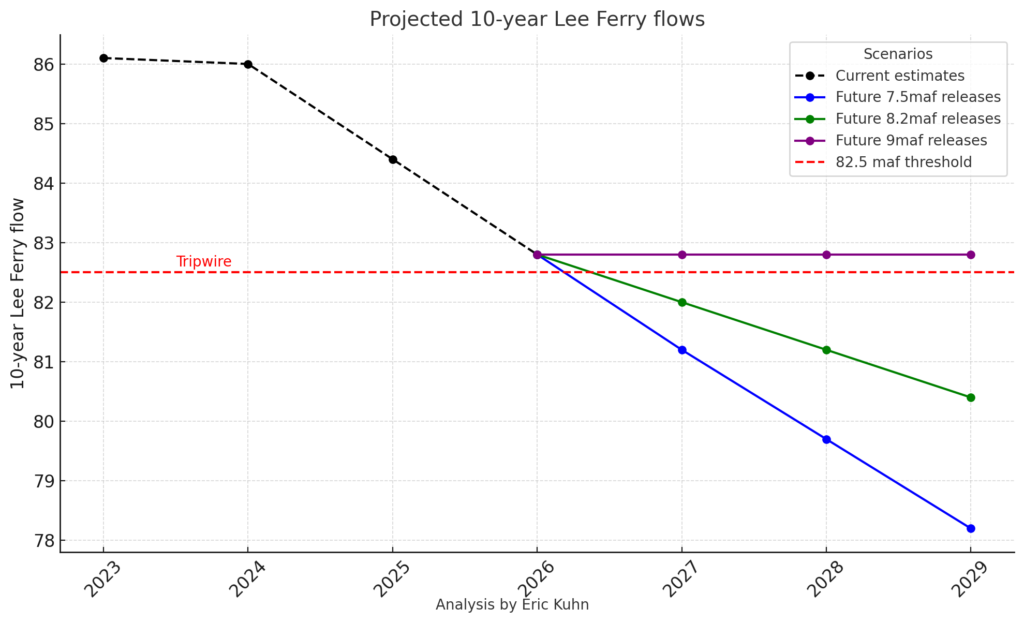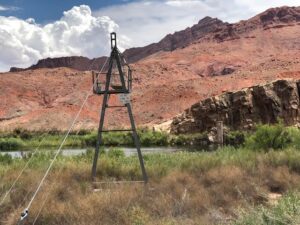
The Tripwire
By Eric Kuhn, John Fleck, and Jack Schmidt
On January 16th, the Bureau of Reclamation released the January 2025 24-Month Study. Based on the January 1st runoff forecast into Lake Powell, the projected “most probable” annual release from Glen Canyon Dam for Water Year 2026 is now 7.48 maf. This needs to be taken as a significant caution sign because it shows that we are on a clear trajectory to hit what Colorado’s Jim Lochhead first called the 1922 Compact’s first “tripwire” (82.5 maf/10-year) as early as 2027. Given the current stalemate between the Upper and Lower Division States over how the reservoir system should be operated, it means the potential for basin-wide litigation is now in the “Red Zone.”
The January 24-Month study is the first in each water year to be based on a published forecast from the Colorado Basin River Forecast Center’s runoff model – the first to be based on actual snowpack. The January 1st runoff forecast for unregulated April-July inflow to Lake Powell was 5.15 maf (about 81% of average). This results in a projected 12/31/2025 elevation of Lake Powell of less than 3575’ making the annual release for Water Year 2026 7.48 maf. Of course, the forecast will change as the winter progresses. In fact, the January mid-month forecast dropped by 300,000 acre-feet to 4.85 maf. At this point in the winter our confidence in the “most probable” forecast is low and in recent years, the track record has been to overstate future runoff suggesting that the we should pay equal attention to the “minimum probable” forecast. (See Wang et al, Evaluating the Accuracy of Reclamation’s 24-Month Study Lake Powell Projections.) Also remember that the actual decision on the WY 2026 release is not made until the Spring runoff is over and the August 24-Month study is released.

Lee/Lee’s/Lees Ferry on the Colorado River. Photo by John Fleck
A 7.48 maf release from Glen Canyon Dam bodes trouble for the basin because it takes us very close to the tripwire. Simply put, the tripwire is the ten-year flow at Lee Ferry at which the Lower Division States can claim the Upper Division States are in violation of the 1922 Compact. Under the compact, the Upper Division States have two specific flow obligations at Lee Ferry: (1) to not cause the ten-year flow to be depleted below 75 maf every ten consecutive years, and (2) to deliver one half of the annual delivery to Mexico under the 1944 Treaty if the “surplus” is not sufficient. If there is no surplus and the delivery to Mexico is 1.5 maf/year, the Upper Division’s share is 750,000 af/year, resulting in a total ten-year delivery obligation of 82.5 maf. Since under Minute 323, Mexico shares in mainstem shortages, recent annual deliveries have been less than 1.5 maf. To keep the math simple, let’s call the current obligation (with no surplus) 82.0 maf. With a 7.48 maf release in WY 2026, the ten-year flow for 2017-2026 will be about 82.8 maf.
Keep in mind that the obligation of the Upper Division States to Mexico under the 1922 Compact has been a disputed issue since the Treaty was signed in 1944. The Lower Division believes there is no current surplus, thus the obligation is one half of the Treaty delivery. The Upper Division believes that since the Lower Basin is currently overusing its 1922 Compact apportionment, this overuse is surplus, and thus, must be delivered to Mexico. Following this thread, if the overuse is greater than 1.5 maf/year, the Upper Division would have no obligation to Mexico.
With an 82.8 maf ten-year flow at the end of Water Year 2026, the Upper Division States are still slightly above the tripwire with a cushion of about 800,000 af. The problem is what happens in the next one to three years. From 2015-2019 annual the annual Glen Canyon Dam releases were 9.0 maf/year. Note, the annual release from Glen Canyon Dam and the flow at Lee Ferry are not quite the same, the Paria River and leakage around the dam contribute another 100,000 -150,000 af/year to the flow at Lee Ferry (bonus flows). Because of the way the ten-year math works, at the end of WY 2027, the Lee Ferry flow for WY 2017 (~9.2 maf) will drop out and be replaced by the 2027 Lee Ferry flow, thus, to keep the ten-year flow greater than 82.0 maf, the 2027 flow will have to be at least 8.4 maf. AND, there are two more 9.0 maf releases in the pipeline, WYs2018 and 2019! That means that when those drop out of the sequence, the risk of the basin stumbling across the tripwire into litigation grows.
To stay above 82.0 maf, the total deliveries at Lee Ferry for the three-year period of 2027-2029, the annual release from Glen Canyon Dam will have to average about 8.8 maf/year (factoring in the bonus flows). Since 2012, the average unregulated inflow to Lake Powell is about 8.2 maf/year. After deducting 500,000 af/year of gross evaporation from the reservoir, the “net-of-evaporation” annual inflow is only about 7.7 maf/year. Going back to 2000, the net inflow is about 7.9 maf/year. Thus, to avoid going below the 82.0 maf tripwire, it will take either above average (post-2000) hydrology or continuing to draw down Lake Powell levels. If the hydrology is a bit drier than the post-2000 (or post-2012) levels, maintaining at least 82.0 maf/10-year may require drawing Lake Powell below minimum power. As Lake Powell levels approach minimum power, we approach environmental and power generation tripwires.
The fact that we’re on track for another year of below-average inflows to Lake Powell, another 7.48 maf/year annual release from Glen Canyon Dam, and on a trajectory to drop below a 1922 Compact tripwire adds another level of urgency for the basin states to break their current impasse over the how the system will be operated post-2026. The chances of Lee Ferry flows dropping below the 82 maf tripwire are high. The Colorado River Basin needs to be fully prepared before this occurs. With every 24-Month study, the basin’s litigation clock is getting closer and closer to that midnight hour.

Thanks for this; it’s great to have the various accounting pieces broken out in a systematic and methodical presentation —
Based on the last 48 hours, I wonder if there will be a next 24-month study. No study, no problem.
Excellent! Thanks for the update! So many commentators are still arguing meaningless points based on River flows that, don’t exist, haven’t existed for some time if at all, and will never exist. They are dividing up “ghost water”. As Governor Lamm used to say, there are hard choices to be made and we can’t ignore them anymore.
Any further thoughts on where tripwire sits? The graphic has it at 82.5 maf, while the post assumes it is 82.0 maf (taking into account Minute 323). Complicated to say the least.
The way it worked for about 80 years with an overallocated river, before the drought and global warming, was that the Upper Basin States took less than their share. It seems to me that a determination of proportional reduction between Upper Basin and Lower Basin would hurt the Upper Basin less than the Lower Basin. Could someone please explain the Upper Basin’s refusal? In any other appropriation-rights setting the Upper Basin would have lost rights because of non use.
Flaming Gorge Reservoir has already passed water to Lake Powell to maintain power production. Could several other Upper Basin reservoirs release water to meet the 82.8 maf requirement, perhaps multiple times, each at the end of a 10-year period?
It seems to me that the Upper Basin is saddled with evaporation from Lake Powell, and the Lower Basin is saddled with evaporation from Lake Mead. Can this become a non-issue? Similarly, can we stop hearing about the original overallocation of the river. The problem is drought and global warming.
Who owns the water from the Little Colorado, Havasu Creek, Virgin River and other tributaries downstream from Lee Ferry, one mile downstream from the mouth of the Paria River?
How do the recent determinations of water rights of Diné people and tribes in northwest New Mexico fit into the declining resource of the Colorado River?